fuel MAZDA 6 2002 Suplement Owners Manual
[x] Cancel search | Manufacturer: MAZDA, Model Year: 2002, Model line: 6, Model: MAZDA 6 2002Pages: 909, PDF Size: 17.16 MB
Page 197 of 909
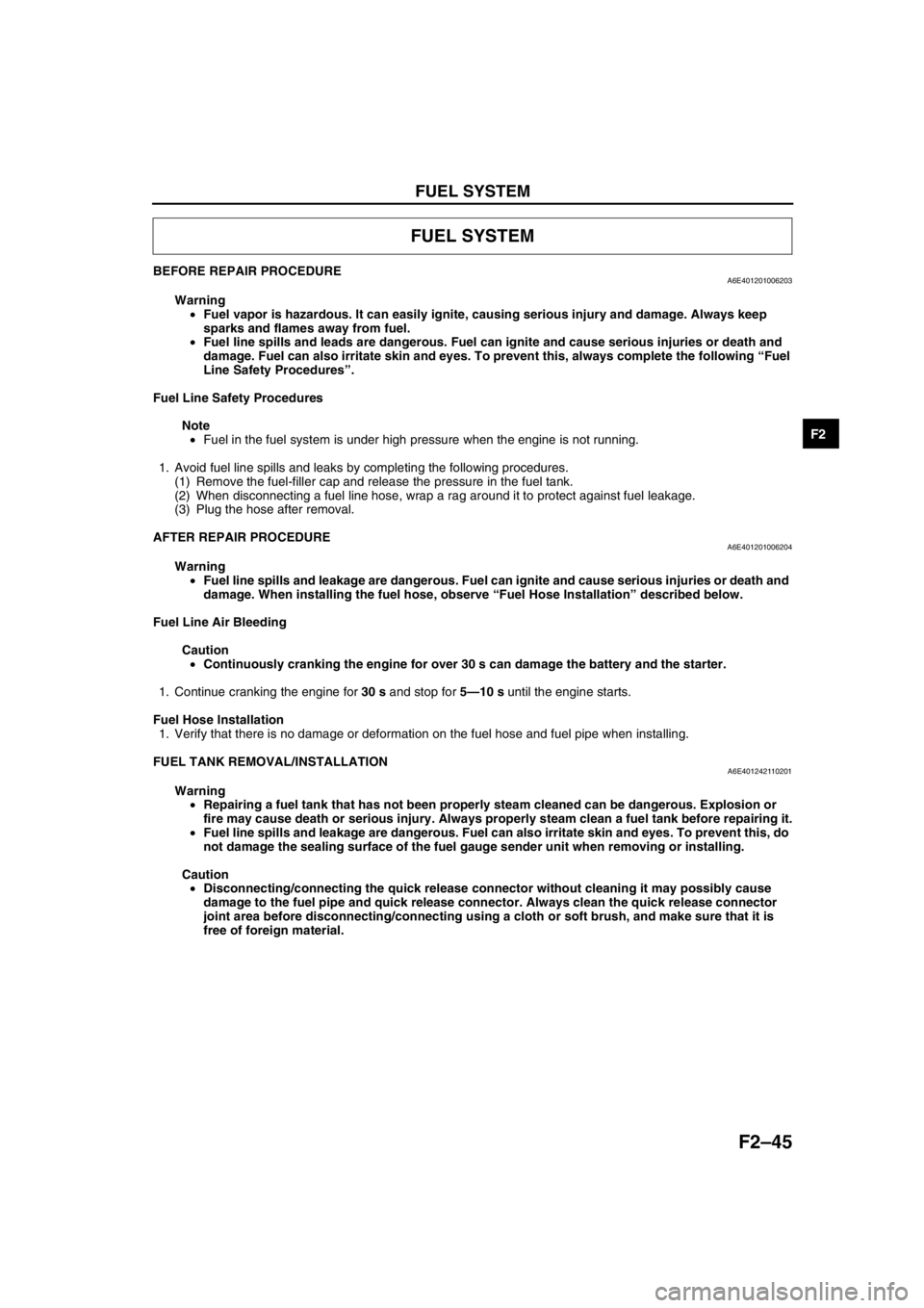
FUEL SYSTEM
F2–45
F2
BEFORE REPAIR PROCEDUREA6E401201006203
Warning
•Fuel vapor is hazardous. It can easily ignite, causing serious injury and damage. Always keep
sparks and flames away from fuel.
•Fuel line spills and leads are dangerous. Fuel can ignite and cause serious injuries or death and
damage. Fuel can also irritate skin and eyes. To prevent this, always complete the following “Fuel
Line Safety Procedures”.
Fuel Line Safety Procedures
Note
•Fuel in the fuel system is under high pressure when the engine is not running.
1. Avoid fuel line spills and leaks by completing the following procedures.
(1) Remove the fuel-filler cap and release the pressure in the fuel tank.
(2) When disconnecting a fuel line hose, wrap a rag around it to protect against fuel leakage.
(3) Plug the hose after removal.
End Of Sie
AFTER REPAIR PROCEDUREA6E401201006204
Warning
•Fuel line spills and leakage are dangerous. Fuel can ignite and cause serious injuries or death and
damage. When installing the fuel hose, observe “Fuel Hose Installation” described below.
Fuel Line Air Bleeding
Caution
•Continuously cranking the engine for over 30 s can damage the battery and the starter.
1. Continue cranking the engine for 30 s and stop for 5—10 s until the engine starts.
Fuel Hose Installation
1. Verify that there is no damage or deformation on the fuel hose and fuel pipe when installing.
End Of Sie
FUEL TANK REMOVAL/INSTALLATIONA6E401242110201
Warning
•Repairing a fuel tank that has not been properly steam cleaned can be dangerous. Explosion or
fire may cause death or serious injury. Always properly steam clean a fuel tank before repairing it.
•Fuel line spills and leakage are dangerous. Fuel can also irritate skin and eyes. To prevent this, do
not damage the sealing surface of the fuel gauge sender unit when removing or installing.
Caution
•Disconnecting/connecting the quick release connector without cleaning it may possibly cause
damage to the fuel pipe and quick release connector. Always clean the quick release connector
joint area before disconnecting/connecting using a cloth or soft brush, and make sure that it is
free of foreign material.
FUEL SYSTEM
Page 198 of 909
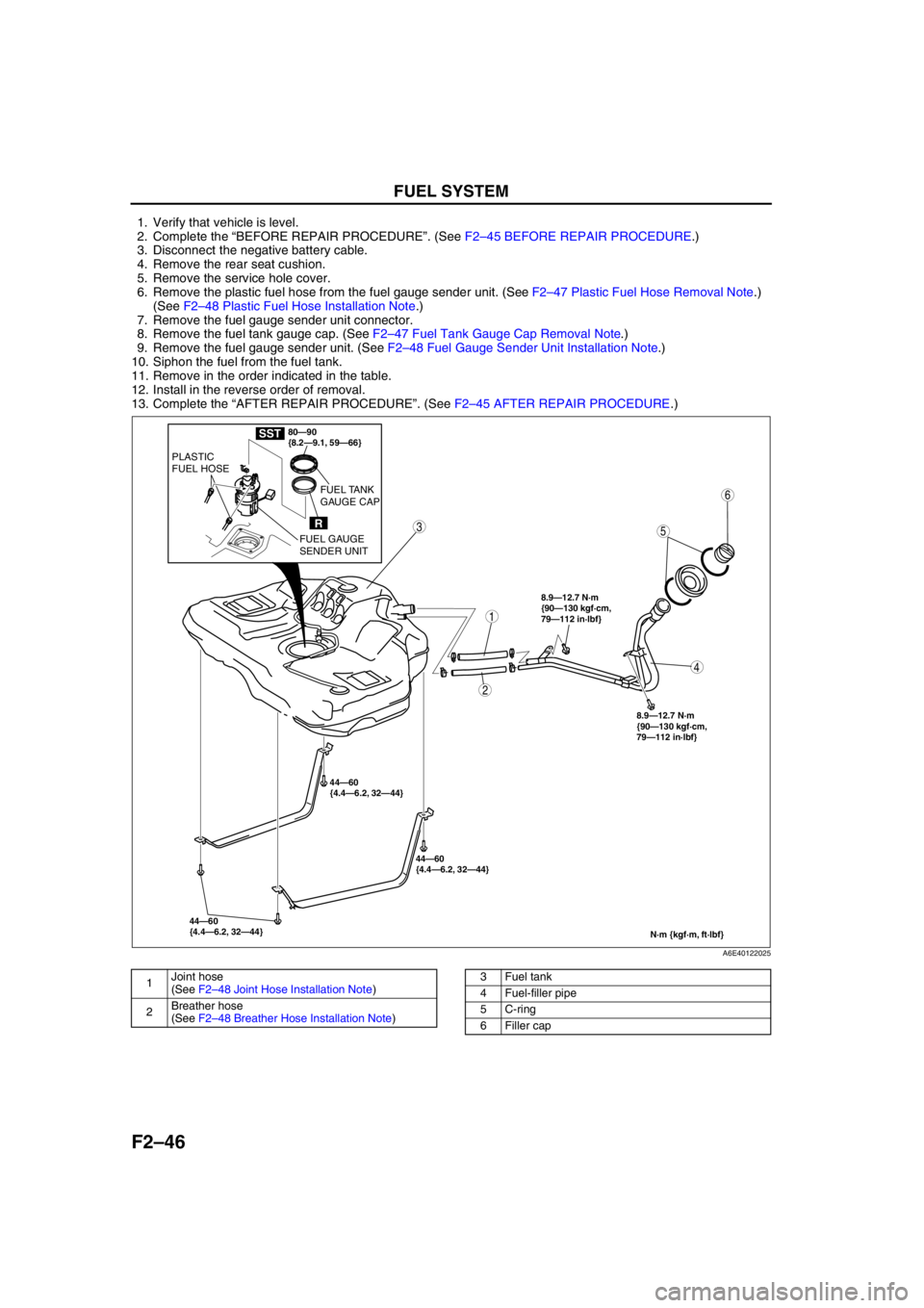
F2–46
FUEL SYSTEM
1. Verify that vehicle is level.
2. Complete the “BEFORE REPAIR PROCEDURE”. (See F2–45 BEFORE REPAIR PROCEDURE.)
3. Disconnect the negative battery cable.
4. Remove the rear seat cushion.
5. Remove the service hole cover.
6. Remove the plastic fuel hose from the fuel gauge sender unit. (See F2–47 Plastic Fuel Hose Removal Note.)
(See F2–48 Plastic Fuel Hose Installation Note.)
7. Remove the fuel gauge sender unit connector.
8. Remove the fuel tank gauge cap. (See F2–47 Fuel Tank Gauge Cap Removal Note.)
9. Remove the fuel gauge sender unit. (See F2–48 Fuel Gauge Sender Unit Installation Note.)
10. Siphon the fuel from the fuel tank.
11. Remove in the order indicated in the table.
12. Install in the reverse order of removal.
13. Complete the “AFTER REPAIR PROCEDURE”. (See F2–45 AFTER REPAIR PROCEDURE.)
.
44—60
{4.4—6.2, 32—44}44—60
{4.4—6.2, 32—44} 44—60
{4.4—6.2, 32—44}
N·m {kgf·m, ft·lbf}
8.9—12.7 N·m
{90—130 kgf·cm,
79—112 in·lbf}
8.9—12.7 N·m
{90—130 kgf·cm,
79—112 in·lbf}
5
4
3
2
1
6
80—90
{8.2—9.1, 59—66}
R
PLASTIC
FUEL HOSE
FUEL GAUGE
SENDER UNITFUEL TANK
GAUGE CAP
SST
A6E40122025
1Joint hose
(See F2–48 Joint Hose Installation Note)
2Breather hose
(See F2–48 Breather Hose Installation Note)3 Fuel tank
4 Fuel-filler pipe
5 C-ring
6 Filler cap
Page 199 of 909

FUEL SYSTEM
F2–47
F2
Plastic Fuel Hose Removal Note
Caution
•The quick release connector may be damaged if the tab is bent excessively. Do not expand the tab
over the stopper.
1. Disconnect the quick release connector.
(1) Push the tab on the locking coupler 90 degrees until it stops.
(2) Pull the fuel hose straight back.
Note
•The stopper may be removed from the quick
connector. Take care not to lose it.
Reinstall it to the quick release connector
before reconnecting the fuel line.
•The locking coupler has two internal locking
tabs which retain the fuel pipe. Be sure that
the tab on the locking coupler is rotated until
it stops to release two internal locking tabs.
2. Cover the disconnected quick release connector
and fuel pipe with vinyl sheets or the like to
prevent them from being scratched or
contaminated with foreign material.
Fuel Tank Gauge Cap Removal Note
1. Using the SST, remove the fuel tank gauge cap.
FUEL PIPE
STOPPER TAB
A6E3912W001
LOCKING TAB
A6E3912W002
A6E3912W039
49 T042 001A
A6A3912W007
Page 200 of 909
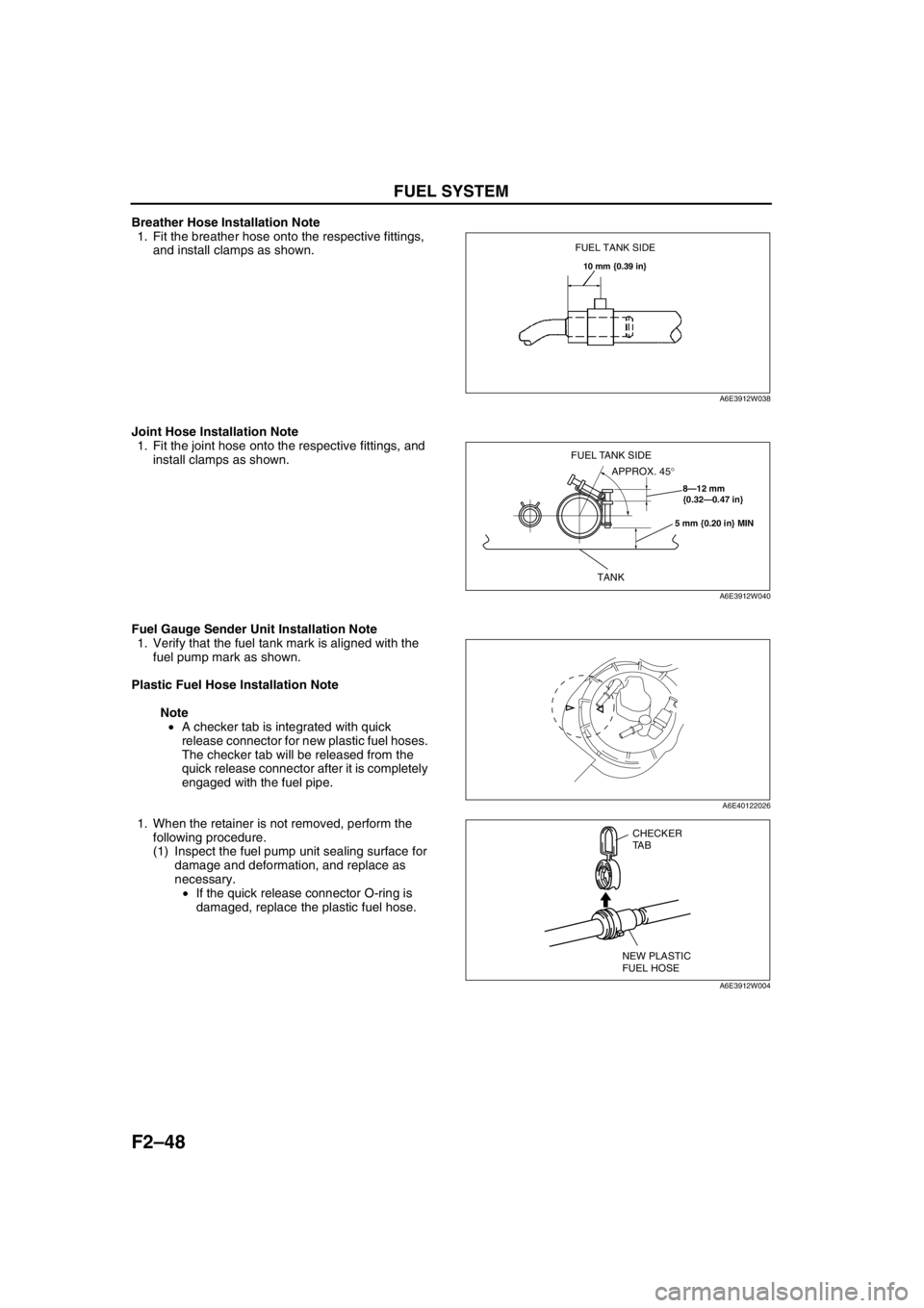
F2–48
FUEL SYSTEM
Breather Hose Installation Note
1. Fit the breather hose onto the respective fittings,
and install clamps as shown.
Joint Hose Installation Note
1. Fit the joint hose onto the respective fittings, and
install clamps as shown.
Fuel Gauge Sender Unit Installation Note
1. Verify that the fuel tank mark is aligned with the
fuel pump mark as shown.
Plastic Fuel Hose Installation Note
Note
•A checker tab is integrated with quick
release connector for new plastic fuel hoses.
The checker tab will be released from the
quick release connector after it is completely
engaged with the fuel pipe.
1. When the retainer is not removed, perform the
following procedure.
(1) Inspect the fuel pump unit sealing surface for
damage and deformation, and replace as
necessary.
•If the quick release connector O-ring is
damaged, replace the plastic fuel hose.
FUEL TANK SIDE
10 mm {0.39 in}
A6E3912W038
8—12 mm
{0.32—0.47 in}
5 mm {0.20 in} MIN
TANK
APPROX. 45° FUEL TANK SIDE
A6E3912W040
A6E40122026
CHECKER
TA B
NEW PLASTIC
FUEL HOSE
A6E3912W004
Page 201 of 909
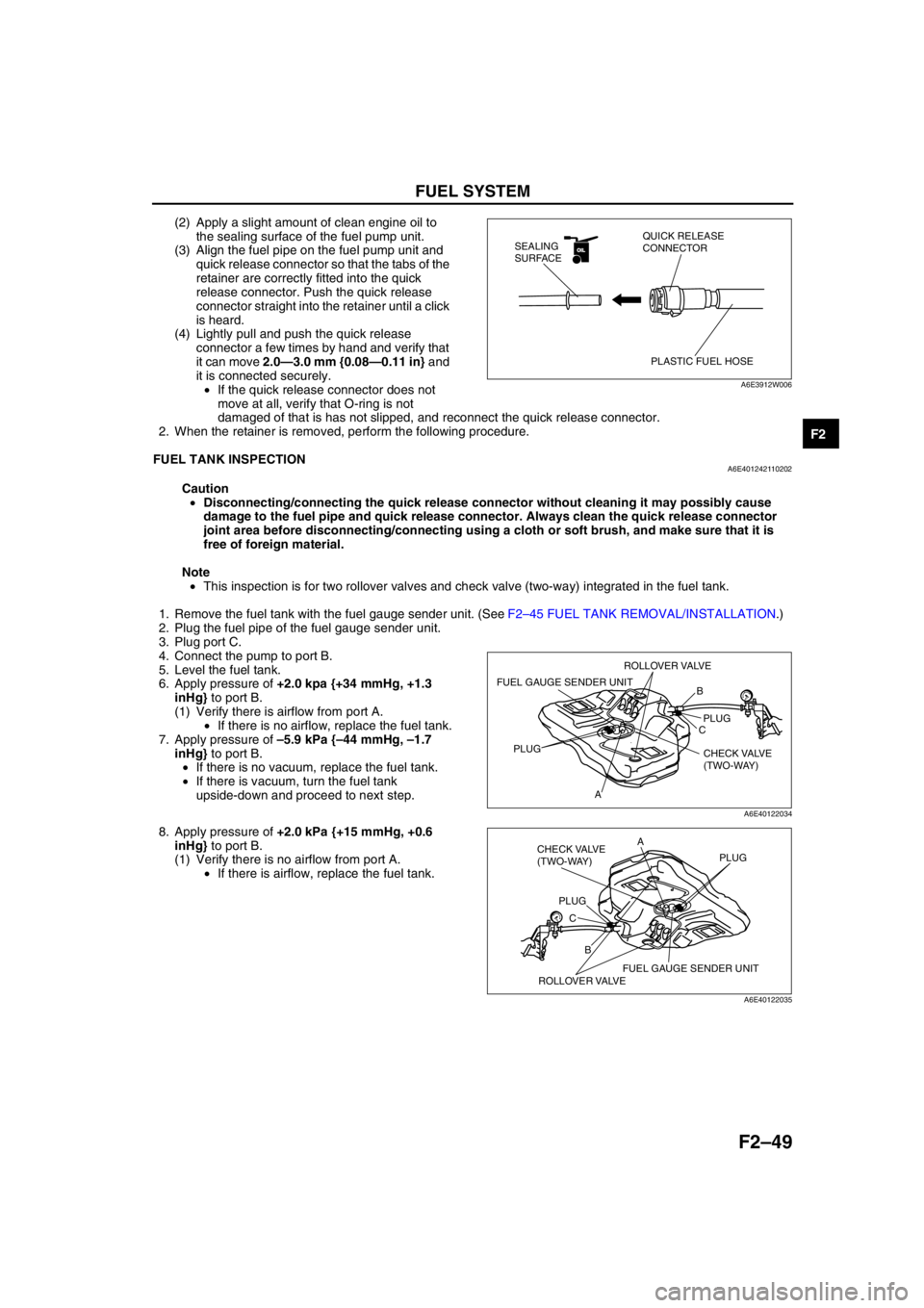
FUEL SYSTEM
F2–49
F2
(2) Apply a slight amount of clean engine oil to
the sealing surface of the fuel pump unit.
(3) Align the fuel pipe on the fuel pump unit and
quick release connector so that the tabs of the
retainer are correctly fitted into the quick
release connector. Push the quick release
connector straight into the retainer until a click
is heard.
(4) Lightly pull and push the quick release
connector a few times by hand and verify that
it can move 2.0—3.0 mm {0.08—0.11 in} and
it is connected securely.
•If the quick release connector does not
move at all, verify that O-ring is not
damaged of that is has not slipped, and reconnect the quick release connector.
2. When the retainer is removed, perform the following procedure.
End Of Sie
FUEL TANK INSPECTIONA6E401242110202
Caution
•Disconnecting/connecting the quick release connector without cleaning it may possibly cause
damage to the fuel pipe and quick release connector. Always clean the quick release connector
joint area before disconnecting/connecting using a cloth or soft brush, and make sure that it is
free of foreign material.
Note
•This inspection is for two rollover valves and check valve (two-way) integrated in the fuel tank.
1. Remove the fuel tank with the fuel gauge sender unit. (See F2–45 FUEL TANK REMOVAL/INSTALLATION.)
2. Plug the fuel pipe of the fuel gauge sender unit.
3. Plug port C.
4. Connect the pump to port B.
5. Level the fuel tank.
6. Apply pressure of +2.0 kpa {+34 mmHg, +1.3
inHg} to port B.
(1) Verify there is airflow from port A.
•If there is no airflow, replace the fuel tank.
7. Apply pressure of –5.9 kPa {–44 mmHg, –1.7
inHg} to port B.
•If there is no vacuum, replace the fuel tank.
•If there is vacuum, turn the fuel tank
upside-down and proceed to next step.
8. Apply pressure of +2.0 kPa {+15 mmHg, +0.6
inHg} to port B.
(1) Verify there is no airflow from port A.
•If there is airflow, replace the fuel tank.
End Of Sie
OILOIL
PLASTIC FUEL HOSE QUICK RELEASE
CONNECTOR SEALING
SURFACE
A6E3912W006
B
C
APLUG
PLUG
CHECK VALVE
(TWO-WAY)
FUEL GAUGE SENDER UNIT
ROLLOVER VALVE
A6E40122034
B CA
PLUGPLUG
CHECK VALVE
(TWO-WAY)
FUEL GAUGE SENDER UNIT
ROLLOVER VALVE
A6E40122035
Page 202 of 909
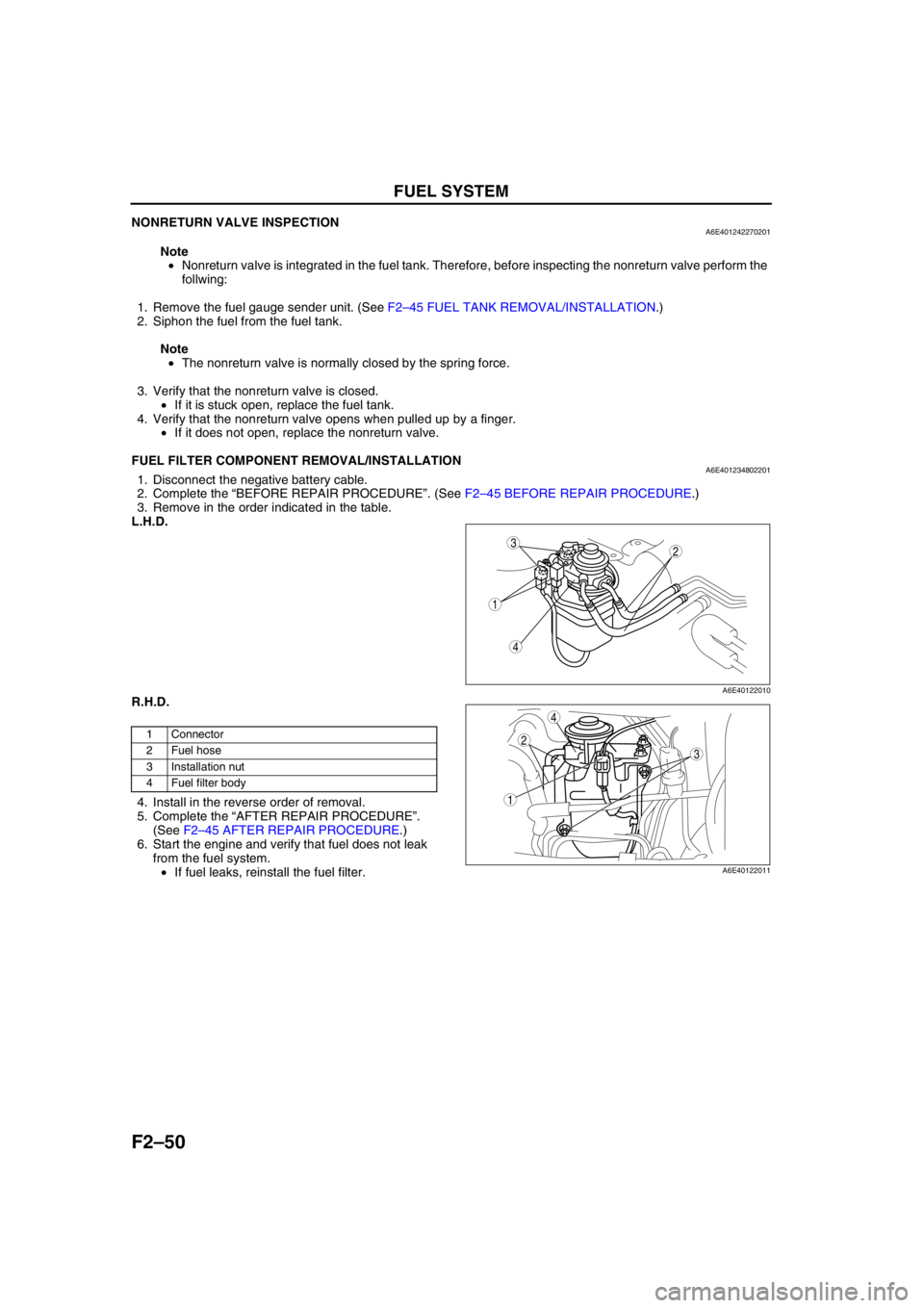
F2–50
FUEL SYSTEM
NONRETURN VALVE INSPECTIONA6E401242270201
Note
•Nonreturn valve is integrated in the fuel tank. Therefore, before inspecting the nonreturn valve perform the
follwing:
1. Remove the fuel gauge sender unit. (See F2–45 FUEL TANK REMOVAL/INSTALLATION.)
2. Siphon the fuel from the fuel tank.
Note
•The nonreturn valve is normally closed by the spring force.
3. Verify that the nonreturn valve is closed.
•If it is stuck open, replace the fuel tank.
4. Verify that the nonreturn valve opens when pulled up by a finger.
•If it does not open, replace the nonreturn valve.
End Of Sie
FUEL FILTER COMPONENT REMOVAL/INSTALLATIONA6E4012348022011. Disconnect the negative battery cable.
2. Complete the “BEFORE REPAIR PROCEDURE”. (See F2–45 BEFORE REPAIR PROCEDURE.)
3. Remove in the order indicated in the table.
L.H.D.
R.H.D.
.
4. Install in the reverse order of removal.
5. Complete the “AFTER REPAIR PROCEDURE”.
(See F2–45 AFTER REPAIR PROCEDURE.)
6. Start the engine and verify that fuel does not leak
from the fuel system.
•If fuel leaks, reinstall the fuel filter.
End Of Sie
1
4
23
A6E40122010
1 Connector
2Fuel hose
3 Installation nut
4 Fuel filter body
4
1
2
3
A6E40122011
Page 203 of 909
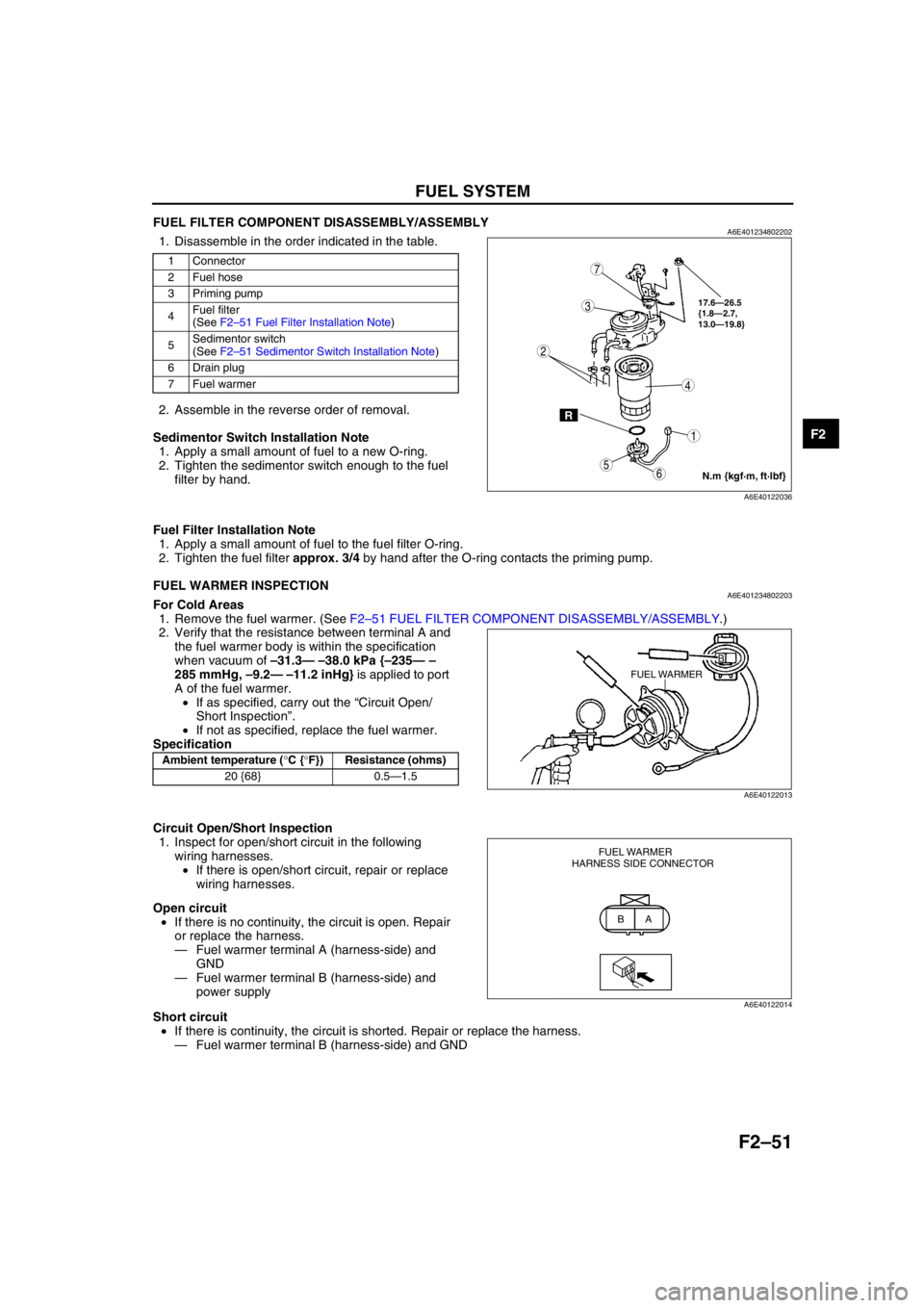
FUEL SYSTEM
F2–51
F2
FUEL FILTER COMPONENT DISASSEMBLY/ASSEMBLYA6E4012348022021. Disassemble in the order indicated in the table..
2. Assemble in the reverse order of removal.
Sedimentor Switch Installation Note
1. Apply a small amount of fuel to a new O-ring.
2. Tighten the sedimentor switch enough to the fuel
filter by hand.
Fuel Filter Installation Note
1. Apply a small amount of fuel to the fuel filter O-ring.
2. Tighten the fuel filter approx. 3/4 by hand after the O-ring contacts the priming pump.
End Of Sie
FUEL WARMER INSPECTIONA6E401234802203For Cold Areas
1. Remove the fuel warmer. (See F2–51 FUEL FILTER COMPONENT DISASSEMBLY/ASSEMBLY.)
2. Verify that the resistance between terminal A and
the fuel warmer body is within the specification
when vacuum of –31.3— –38.0 kPa {–235— –
285 mmHg, –9.2— –11.2 inHg} is applied to port
A of the fuel warmer.
•If as specified, carry out the “Circuit Open/
Short Inspection”.
•If not as specified, replace the fuel warmer.
Specification
Circuit Open/Short Inspection
1. Inspect for open/short circuit in the following
wiring harnesses.
•If there is open/short circuit, repair or replace
wiring harnesses.
Open circuit
•If there is no continuity, the circuit is open. Repair
or replace the harness.
—Fuel warmer terminal A (harness-side) and
GND
—Fuel warmer terminal B (harness-side) and
power supply
Short circuit
•If there is continuity, the circuit is shorted. Repair or replace the harness.
—Fuel warmer terminal B (harness-side) and GND
End Of Sie
1 Connector
2 Fuel hose
3 Priming pump
4Fuel filter
(See F2–51 Fuel Filter Installation Note)
5Sedimentor switch
(See F2–51 Sedimentor Switch Installation Note)
6 Drain plug
7 Fuel warmer
R
17.6—26.5
{1.8—2.7,
13.0—19.8}
7
5
4
3
6
1
2
N.m {kgf·m, ft·lbf}
A6E40122036
Ambient temperature (°C {°F}) Resistance (ohms)
20 {68} 0.5—1.5
FUEL WARMER
B
A6E40122013
A B FUEL WARMER
HARNESS SIDE CONNECTOR
A6E40122014
Page 204 of 909
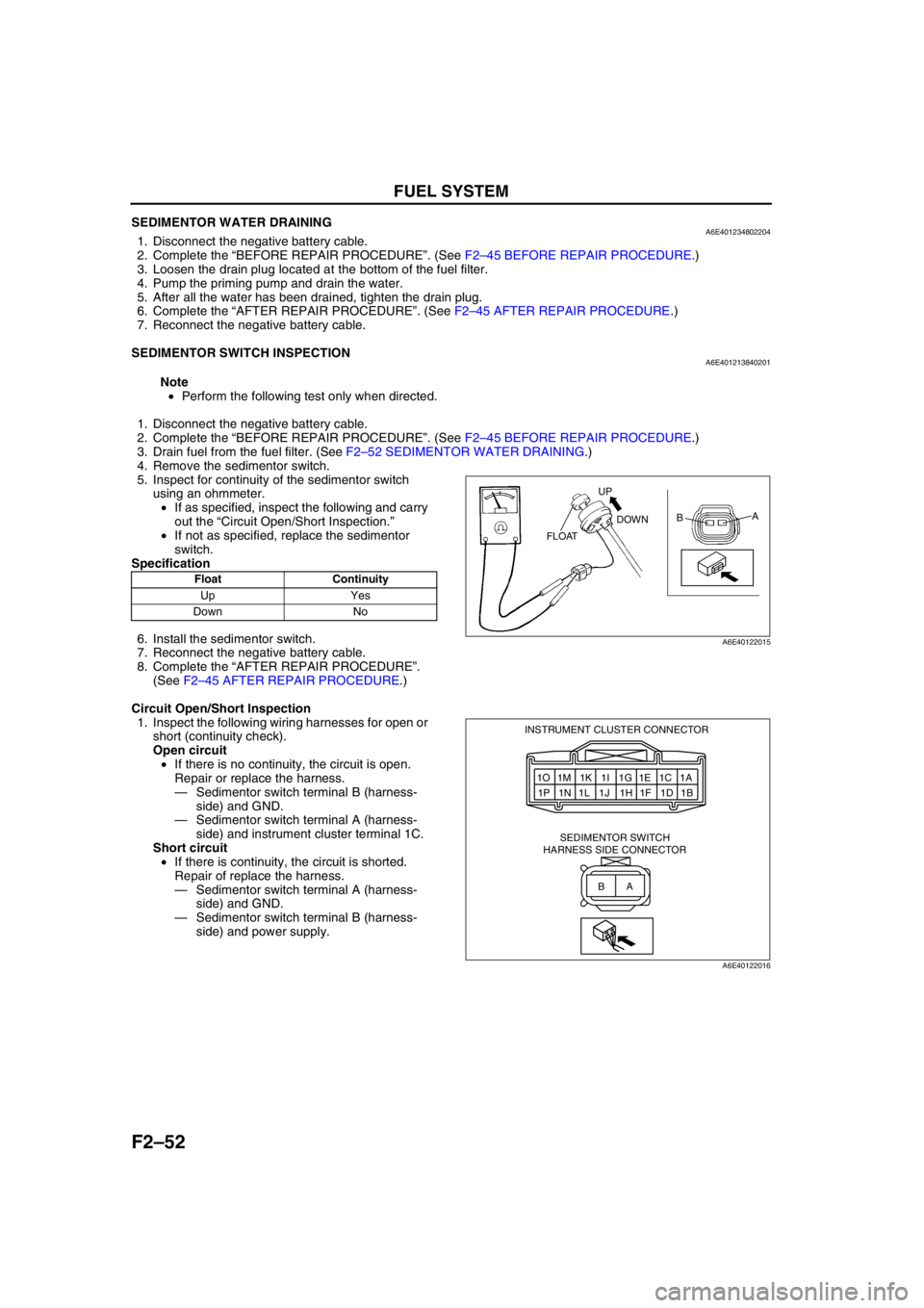
F2–52
FUEL SYSTEM
SEDIMENTOR WATER DRAININGA6E4012348022041. Disconnect the negative battery cable.
2. Complete the “BEFORE REPAIR PROCEDURE”. (See F2–45 BEFORE REPAIR PROCEDURE.)
3. Loosen the drain plug located at the bottom of the fuel filter.
4. Pump the priming pump and drain the water.
5. After all the water has been drained, tighten the drain plug.
6. Complete the “AFTER REPAIR PROCEDURE”. (See F2–45 AFTER REPAIR PROCEDURE.)
7. Reconnect the negative battery cable.
End Of Sie
SEDIMENTOR SWITCH INSPECTIONA6E401213840201
Note
•Perform the following test only when directed.
1. Disconnect the negative battery cable.
2. Complete the “BEFORE REPAIR PROCEDURE”. (See F2–45 BEFORE REPAIR PROCEDURE.)
3. Drain fuel from the fuel filter. (See F2–52 SEDIMENTOR WATER DRAINING.)
4. Remove the sedimentor switch.
5. Inspect for continuity of the sedimentor switch
using an ohmmeter.
•If as specified, inspect the following and carry
out the “Circuit Open/Short Inspection.”
•If not as specified, replace the sedimentor
switch.
Specification
6. Install the sedimentor switch.
7. Reconnect the negative battery cable.
8. Complete the “AFTER REPAIR PROCEDURE”.
(See F2–45 AFTER REPAIR PROCEDURE.)
Circuit Open/Short Inspection
1. Inspect the following wiring harnesses for open or
short (continuity check).
Open circuit
•If there is no continuity, the circuit is open.
Repair or replace the harness.
—Sedimentor switch terminal B (harness-
side) and GND.
—Sedimentor switch terminal A (harness-
side) and instrument cluster terminal 1C.
Short circuit
•If there is continuity, the circuit is shorted.
Repair of replace the harness.
—Sedimentor switch terminal A (harness-
side) and GND.
—Sedimentor switch terminal B (harness-
side) and power supply.
End Of Sie
Float Continuity
Up Yes
Down No
UP
DOWN
FLOATA
B
A6E40122015
1O 1M 1K 1I 1G 1E 1C 1A
1P 1N 1L 1J 1H 1F 1D 1B INSTRUMENT CLUSTER CONNECTOR
SEDIMENTOR SWITCH
HARNESS SIDE CONNECTOR
A
B
A6E40122016
Page 205 of 909
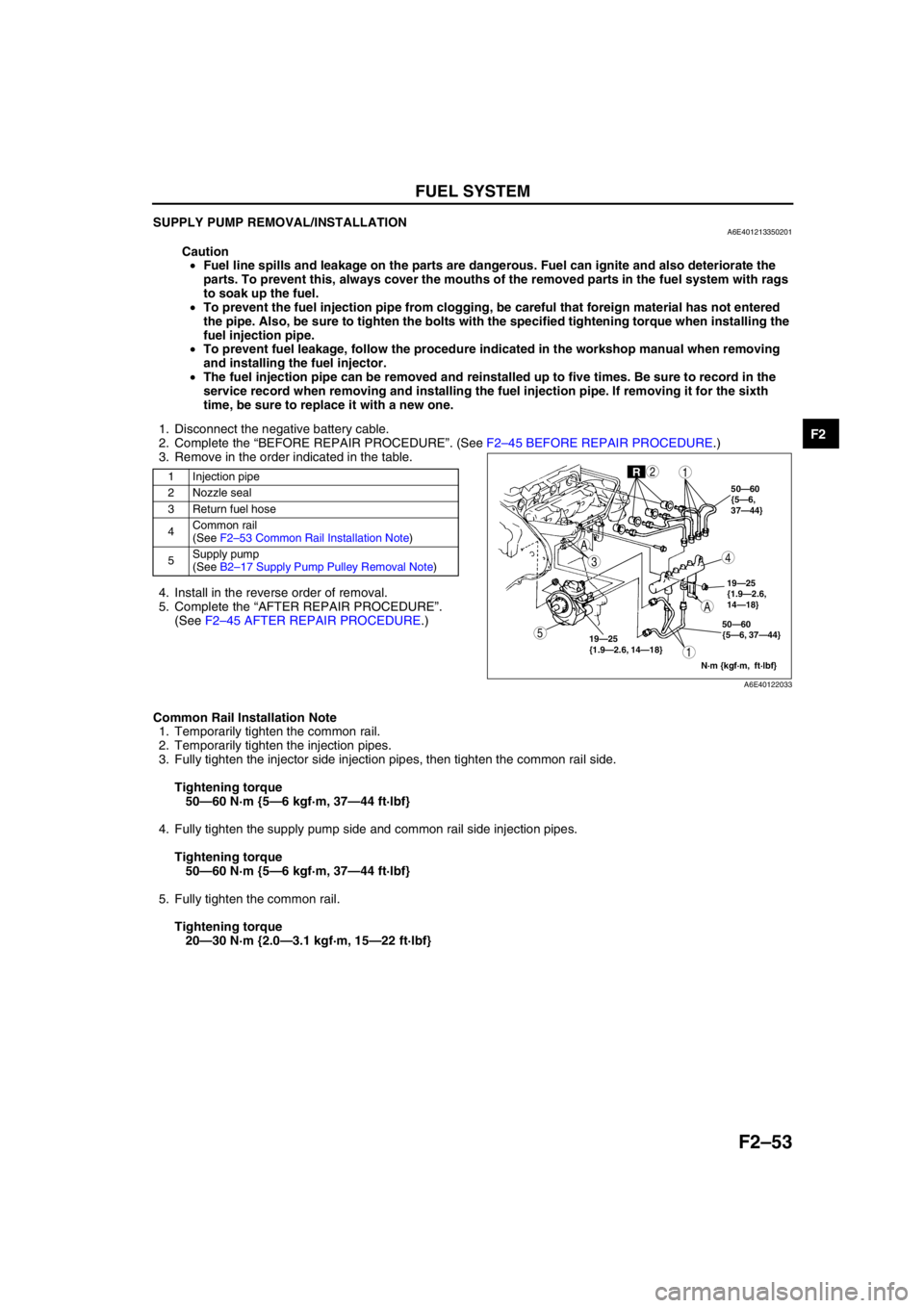
FUEL SYSTEM
F2–53
F2
SUPPLY PUMP REMOVAL/INSTALLATIONA6E401213350201
Caution
•Fuel line spills and leakage on the parts are dangerous. Fuel can ignite and also deteriorate the
parts. To prevent this, always cover the mouths of the removed parts in the fuel system with rags
to soak up the fuel.
•To prevent the fuel injection pipe from clogging, be careful that foreign material has not entered
the pipe. Also, be sure to tighten the bolts with the specified tightening torque when installing the
fuel injection pipe.
•To prevent fuel leakage, follow the procedure indicated in the workshop manual when removing
and installing the fuel injector.
•The fuel injection pipe can be removed and reinstalled up to five times. Be sure to record in the
service record when removing and installing the fuel injection pipe. If removing it for the sixth
time, be sure to replace it with a new one.
1. Disconnect the negative battery cable.
2. Complete the “BEFORE REPAIR PROCEDURE”. (See F2–45 BEFORE REPAIR PROCEDURE.)
3. Remove in the order indicated in the table.
.
4. Install in the reverse order of removal.
5. Complete the “AFTER REPAIR PROCEDURE”.
(See F2–45 AFTER REPAIR PROCEDURE.)
Common Rail Installation Note
1. Temporarily tighten the common rail.
2. Temporarily tighten the injection pipes.
3. Fully tighten the injector side injection pipes, then tighten the common rail side.
Tightening torque
50—60 N·m {5—6 kgf·m, 37—44 ft·lbf}
4. Fully tighten the supply pump side and common rail side injection pipes.
Tightening torque
50—60 N·m {5—6 kgf·m, 37—44 ft·lbf}
5. Fully tighten the common rail.
Tightening torque
20—30 N·m {2.0—3.1 kgf·m, 15—22 ft·lbf}
End Of Sie
1 Injection pipe
2 Nozzle seal
3 Return fuel hose
4Common rail
(See F2–53 Common Rail Installation Note)
5Supply pump
(See B2–17 Supply Pump Pulley Removal Note)
19—25
{1.9—2.6, 14—18}19—25
{1.9—2.6,
14—18} 50—60
{5—6,
37—44}
50—60
{5—6, 37—44}
N·m {kgf·m, ft·lbf}
A
R
A
5
43
12
1
A6E40122033
Page 206 of 909
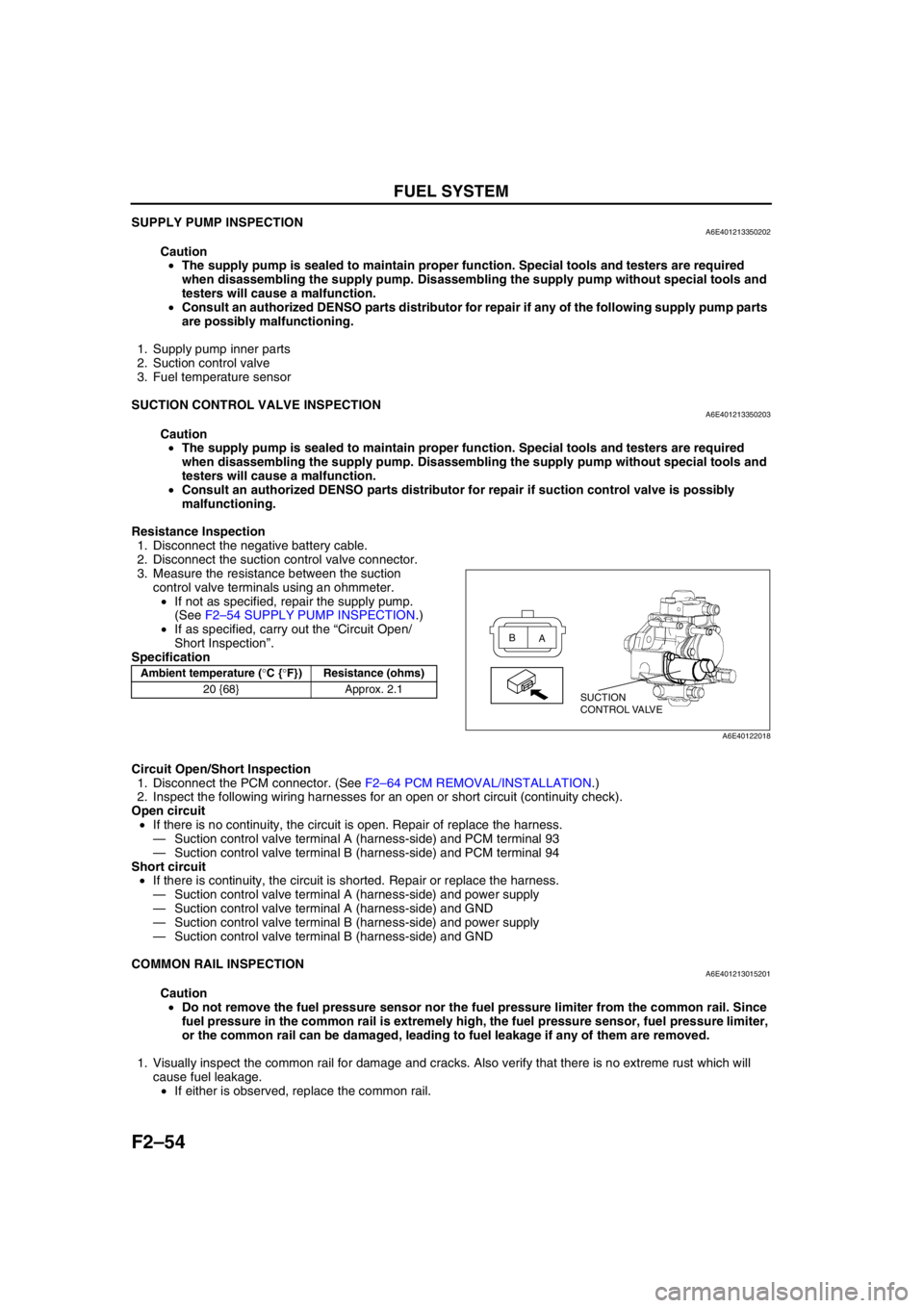
F2–54
FUEL SYSTEM
SUPPLY PUMP INSPECTIONA6E401213350202
Caution
•The supply pump is sealed to maintain proper function. Special tools and testers are required
when disassembling the supply pump. Disassembling the supply pump without special tools and
testers will cause a malfunction.
•Consult an authorized DENSO parts distributor for repair if any of the following supply pump parts
are possibly malfunctioning.
1. Supply pump inner parts
2. Suction control valve
3. Fuel temperature sensor
End Of Sie
SUCTION CONTROL VALVE INSPECTIONA6E401213350203
Caution
•The supply pump is sealed to maintain proper function. Special tools and testers are required
when disassembling the supply pump. Disassembling the supply pump without special tools and
testers will cause a malfunction.
•Consult an authorized DENSO parts distributor for repair if suction control valve is possibly
malfunctioning.
Resistance Inspection
1. Disconnect the negative battery cable.
2. Disconnect the suction control valve connector.
3. Measure the resistance between the suction
control valve terminals using an ohmmeter.
•If not as specified, repair the supply pump.
(See F2–54 SUPPLY PUMP INSPECTION.)
•If as specified, carry out the “Circuit Open/
Short Inspection”.
Specification
Circuit Open/Short Inspection
1. Disconnect the PCM connector. (See F2–64 PCM REMOVAL/INSTALLATION.)
2. Inspect the following wiring harnesses for an open or short circuit (continuity check).
Open circuit
•If there is no continuity, the circuit is open. Repair of replace the harness.
—Suction control valve terminal A (harness-side) and PCM terminal 93
—Suction control valve terminal B (harness-side) and PCM terminal 94
Short circuit
•If there is continuity, the circuit is shorted. Repair or replace the harness.
—Suction control valve terminal A (harness-side) and power supply
—Suction control valve terminal A (harness-side) and GND
—Suction control valve terminal B (harness-side) and power supply
—Suction control valve terminal B (harness-side) and GND
End Of Sie
COMMON RAIL INSPECTIONA6E401213015201
Caution
•Do not remove the fuel pressure sensor nor the fuel pressure limiter from the common rail. Since
fuel pressure in the common rail is extremely high, the fuel pressure sensor, fuel pressure limiter,
or the common rail can be damaged, leading to fuel leakage if any of them are removed.
1. Visually inspect the common rail for damage and cracks. Also verify that there is no extreme rust which will
cause fuel leakage.
•If either is observed, replace the common rail.
End Of Sie
Ambient temperature (°C {°F}) Resistance (ohms)
20 {68} Approx. 2.1
SUCTION
CONTROL VALVE A B
A6E40122018